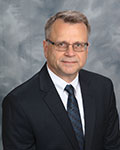September 2018, Vol. 245, No. 9
Features
GITA's Limbruner sees Bright Future for Sector
Pipeline & Gas Journal Staff Report

Mark Limbruner, the current president of the Geospacial Information & Technology Association (GITA), has spent more than three decades in the geospatial industry working for a number of firms in the petroleum exploration, coal exploration, mining, environmental engineering and GIS consulting fields. Since 2008, he has been employed by Range Resources Corporation in the Canonsburg, Penn., office, where he manages the Southern Marcellus Shale Division’s GIS department.
Throughout his career, Limbruner has presented at national and regional GIS conferences, and he has served on the organizing committee for the GITA Oil and Gas Pipeline Conference. The 27th annual conference will be held this year in Houston, Oct. 16-17, as part of the Pipeline Technology Forum (formerly Pipeline Week).
Limbruner has been a member of the GITA Board since 2013 and served as GITA president, 2015-2016. He also has co-chaired EnerGIS, an annual GIS conference focused on the energy industry in the U.S. Northeast.
P&GJ: Mark, how did you get involved with GITA, and what are your current responsibilities?
Limbruner: I was invited to speak at one of GITA’s conferences back in 2010 and was impressed with the advisory panel’s commitment and professionalism. I was asked to join and assist with the panel’s E&P outreach efforts.
From that initiative, several GITA members launched our EnerGIS conference held annually in Pittsburgh. The success of EnerGIS then led to a slot on the GITA board of directors, and eventually serving as president these past four years.
Leadership really entails keeping the board focused on the association’s goals, as well as directing our contracted management staff. I also spend a significant amount of time working with firms and other associations who co-produce conferences with GITA.
P&GJ: What is the current state of the industry?
Limbruner: Things could not be better in the geospatial sector. The transmission, midstream, gathering and E&P sectors of the industry have a voracious appetite for geospatial services.
The latest technologies in data management, drones/UAV’s, GPS, aerial photography, remote sensing, satellite photography, have provided GIS practitioners a tremendous number of tools available to help their firms’ management and technical teams make the proper decision on operations and expansion.
P&GJ: Discuss GITA’s history and where the organization is headed.
Limbruner: GITA traces its roots back to the late 1960s, when the first CAD/automated mapping systems were developed. In 1982, a formal, organization was chartered to serve this growing industry, Automated Mapping/Facilities Management International (AM/FM International).
In 1998, the association changed its name to the Geospatial Information & Technology Association, in order to better reflect its focus.
GITA has maintained an educational focus to the present day. Recognizing that the geospatial industry has evolved, the board revised our mission statement to reflect a new vision. GITA current mission is to enrich and educate the broader geospatial community, as well as to help connect and advocate for geospatial practitioners. This includes, education, training, conferences and lobbying on behalf of the geospatial community.
P&GJ: Mark, talk about the benefits of attending the Pipeline Technology Forum.
Limbruner: The Pipeline Technology Forum, formerly known as Pipeline Week, is a gathering of geospatial and information technology professionals focused on the oil and gas pipeline industry. Talks, presentations and panelists will speak on various aspects of locating and operating pipelines in a safe and environmentally sound manner. Besides the formal sessions, I believe attendees get a tremendous benefit by networking with their colleagues and learning from the vendors on hand. Discussing shared concerns, experiences and solutions is the greatest benefit to attendees.
P&GJ: How do you balance your positions at GITA and Range Resources and the challenges they provide?
Limbruner: I really have to thank the leadership at Range Resources for allowing me to assist the geospatial community by serving GITA. The corporation has been most gracious anytime I have needed to attend to association business. Additionally, Range donates its conference and facilities to GITA to host our EnerGIS conference. I can’t say enough about how well Range has supported GITA.
Regarding balancing my “day job” with my GITA duties, I’d have to say attending to GITA really needs to be viewed as a hobby. I believe that anyone volunteering for a trade or industry association donates hundreds of hours of their personal time to these efforts. The work, though, pays dividends in the satisfaction gained by meeting new friends and making professional contacts that have benefitted me both personally and professionally. P&GJ





Comments